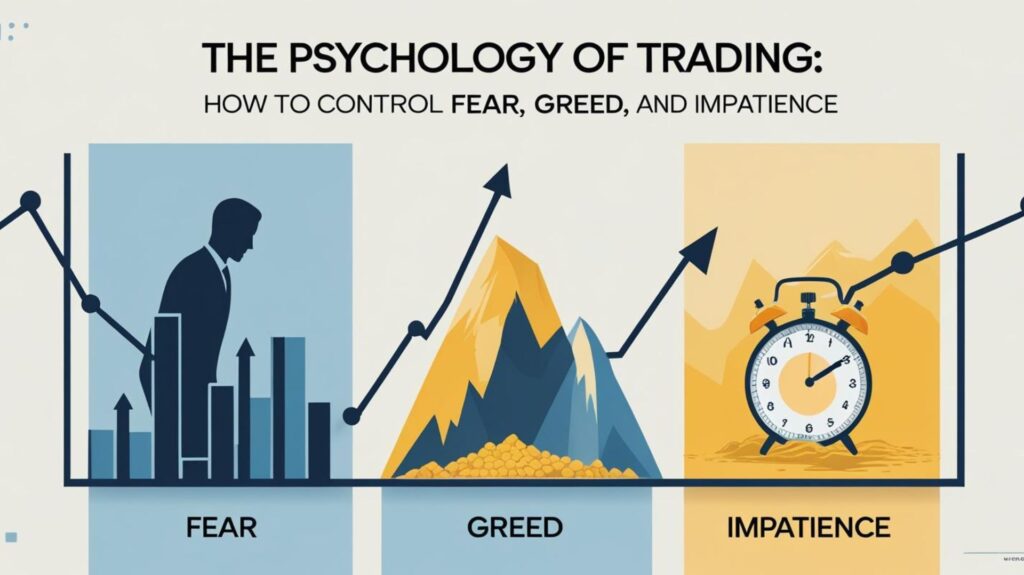The Psychology of Trading: How to Control Fear, Greed, and Impatience

Blog Details Trading isn’t just about technical analysis, charts, or market news — it’s equally about controlling your mindset. In fact, mastering trading psychology can be the difference between consistent profits and costly mistakes. If you’ve ever exited too early, held on too long, or entered impulsively — you’re not alone. These behaviors are emotionally driven. This blog will help you understand how fear, greed, and impatience impact trading and how to conquer them for good. 🔍 1. Understanding Fear in Trading Fear often shows up when:n You’re unsure of your strategy. You’ve had a recent loss. You’re risking too much capital. Fear can lead to hesitation, missed opportunities, or exiting trades too early. To handle fear: Backtest your strategy and build confidence in it. Use smaller position sizes. Stick to your stop-loss. 💰 2. Tackling Greed: The Silent Capital Killer Greed makes traders: Ignore exit points hoping for more profit. Overtrade during a winning streak. Double down on risky positions. To keep greed in check: Set realistic profit targets. Journal your trades to analyze behavior. Remind yourself: “Profit is profit — no one went broke booking gains.” ⏳ 3. Impatience: The Urge to Trade Every Candle Impatience makes you: Enter trades too early without confirmation. Chase after every movement. Get frustrated waiting for setups. How to stay patient: Use alerts to notify you of valid setups. Avoid watching the screen all day. Practice mindfulness or deep breathing to reduce anxiety. 🎯 4. Develop a Strong Trading Mindset Have a Plan: Entry, exit, stop-loss, risk-reward — write it all down. Risk Management: Never risk more than 1–2% per trade. Follow a Routine: Journal daily. Reflect weekly. Accept Losses: Even the best traders lose sometimes. Take Breaks: A calm mind is sharper than a stressed one. 🧠 Trade with Bhagyashri: Learn the Mental Edge At Trade with Bhagyashri, we don’t just teach charts — we teach mindset mastery. Our online & offline courses cover: Trading psychology basics Real-world examples from Indian markets Guided emotional control techniques 📢 Final Thought The biggest enemy in trading isn’t the market — it’s your mind. Train your emotions like you train your strategy, and you’ll be ahead of most traders.
How to Control Emotions While Trading

Blog Details Trading is not just about charts, strategies, or technical analysis — it’s also about mastering your mindset. Emotional trading leads to impulsive decisions, poor risk management, and ultimately, losses. If you want to be a successful trader, learning how to control emotions is crucial. Why Emotions Matter in Trading Every decision you make in the market is either supported or sabotaged by your emotions. Fear, greed, impatience, overconfidence — all of these can lead to: Exiting too early Holding onto losing trades Overtrading Ignoring stop-losses Common Emotional Triggers Fear of Missing Out (FOMO) Jumping into trades because everyone else is Greed Holding on too long hoping for more profit Revenge Trading Trying to recover losses with random trades Overconfidence After a winning streak, risking more than usual 7 Powerful Ways to Control Emotions in Trading 1. Follow a Trading Plan Have a clearly defined plan with entry, exit, and stop-loss levels. Stick to it, no matter how tempting it is to deviate. 2. Accept Losses as Part of the Game No one wins every trade. Accepting small losses is part of trading wisely. 3. Use Proper Risk Management Never risk more than 1–2% of your capital per trade. Knowing your maximum loss helps reduce emotional pressure. 4. Keep a Trading Journal Record every trade, along with the reason you took it and how you felt. Review it weekly to track patterns and emotional triggers. 5. Take Breaks If you feel frustrated or overexcited, step away. Clear your mind before making the next move. 6. Avoid Trading to Recover Losses Revenge trading is one of the fastest ways to blow your capital. Let the market reset, and come back with a fresh mindset. 7. Practice Meditation or Mindfulness Just 5-10 minutes a day can help calm your nervous system, improve focus, and reduce reactive behavior. Learn Trading Psychology with Trade with Bhagyashri At Trade with Bhagyashri, we focus not just on strategies but also on trader mindset. Our offline and online courses include: Live trading psychology sessions Practical emotional control techniques Real examples from Indian markets
Stock Market for Beginners: How to Start Trading in India the Right Way

Blog Details Entering the stock market for the first time can feel overwhelming — too many terms, too many platforms, and too much risk. But with the right guidance, trading in India can become a smart, strategic way to build wealth. In this beginner’s guide, we’ll break down how to start trading in the Indian stock market the right way. What Is the Stock Market? The stock market is a platform where companies list their shares for the public to invest in. These shares are traded through stock exchanges like the NSE (National Stock Exchange) and BSE (Bombay Stock Exchange). Investors and traders buy and sell shares to profit from price movements or earn dividends. Step-by-Step Guide to Start Trading in India 1. Understand the Basics Before you risk any money, learn basic concepts like: What are shares, IPOs, and indices (like Nifty 50, Sensex)? The difference between trading and investing What are bull markets vs bear markets? 2. Open a Trading + Demat Account To buy or sell shares in India, you need: A Demat Account to store your shares digitally A Trading Account to place orders Popular brokers include: Zerodha Upstox Groww Angel One 3. Link Your Bank Account Ensure your savings bank account is linked with your trading account for easy fund transfers. 4. Learn Technical and Fundamental Analysis Fundamental analysis: Understanding company performance, financials, and news Technical analysis: Reading charts, candlestick patterns, indicators like RSI and MACD 5. Start with Small Capital Don’t jump in with all your savings. Start small and learn: How the market reacts to news How to set stop-loss and target The importance of patience and discipline 6. Choose Your Trading Style Intraday: Buy and sell within a day Swing Trading: Hold for days or weeks Positional Trading: Hold for weeks or months Investing: Long-term wealth creation 7. Use Tools and Platforms Use apps like: TradingView for charting and analysis Moneycontrol or TickerTape for stock info Chartink for scanning patterns 8. Practice with Paper Trading Before going live, try virtual trading to test your strategy. Mistakes to Avoid as a Beginner Overtrading due to excitement Blindly following tips or Telegram groups Ignoring risk management Trading without learning or mentorship Join a Trading Course for Faster Growth If you’re serious about learning trading step-by-step, join a structured course. At Trade with Bhagyashri, we help beginners: Learn candlestick patterns and chart reading Understand market psychology Practice in live market conditions Build consistent strategies 📘 Bonus Tip: Start reading simple eBooks on trading concepts. You can download beginner-friendly books directly from our website. 🧠 Still confused? Read our next blog: “Mastering Candlestick Patterns: A Visual Guide” for more insight.
Mastering Candlestick Patterns: A Visual Guide for Beginners

Blog Details If you’re serious about improving your trading skills, understanding candlestick patterns is an essential first step. Candlesticks are more than just colorful bars on a chart — they represent price action, market psychology, and trader behavior. In this beginner-friendly guide, you’ll learn how to read candlestick patterns, recognize the most important formations, and apply them to real trades. What Are Candlestick Patterns? Candlestick patterns are visual representations of price movement over a specific period. Each candle reflects four key pieces of information: open, high, low, and close. When you learn to interpret these patterns, you can make smarter trading decisions based on momentum, trend strength, and potential reversals. Why Learn Candlestick Patterns? They help you identify market trends and reversals early They improve entry and exit timing They’re universally used by traders, from beginners to professionals They can be combined with indicators for more accurate setups Bullish vs Bearish Patterns Candlestick patterns fall into two major categories: Bullish Patterns: Suggest the price may rise. Typically found at the bottom of a downtrend. Bearish Patterns: Indicate potential price drops. Usually seen at the top of an uptrend. 5 Must-Know Candlestick Patterns 1. Hammer (Bullish Reversal) Appears after a downtrend Small body, long lower wick Indicates buyers are gaining strength 2. Engulfing Pattern Bullish: Green candle fully covers the previous red candle Bearish: Red candle completely engulfs the previous green candle Reliable on higher time frames like 1-hour or daily 3. Doji Tiny or no body with long wicks Shows indecision in the market Use confirmation candle to trade 4. Morning Star (Bullish Reversal) Three-candle pattern: Red candle Small-bodied candle (Doji or Spinning Top) Strong green candle Seen near support zones 5. Shooting Star (Bearish Reversal) Appears after an uptrend Small body with long upper wick Signals weakness in buying pressure Tools to Practice Candlestick Reading TradingView: Free charting tool with replay feature Chartink: Pattern scanner for Indian stocks Notion/Excel: For maintaining a candle journal with screenshots Common Mistakes to Avoid Trading every pattern without confirmation Ignoring volume or market context Forgetting to use stop-losses Overtrading based on just one signal Final Tips Always combine candlestick patterns with trend lines, support/resistance, and indicators like RSI or VWAP Backtest strategies before using them in live trades Practice daily and maintain a trade journal
